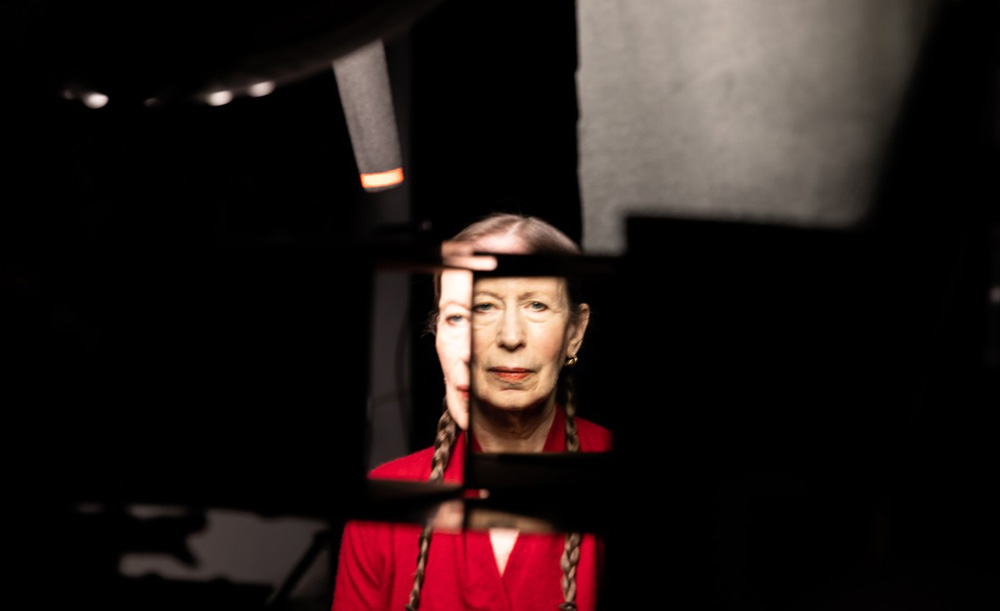For the moment that Meredith Monk describes her biggest creative breakthrough in “Monk in Pieces: A Concept Album,” filmmaker Billy Shebar cleverly draws on a number of various interviews to show her refine her answer as she tried to explain it to others. Monk, who was destined to be a singer when her grandfather was a bass baritone and her mother keep a roof over her family’s head by crooning commercial jingles for Blue Bonnet Margarine, among other companies, found her voice to be no different than her hand as an instrument, believing there were various points of contact like her figures and tonal fluctuations could “express shades of feeling.” Fittingly, it was a discovery that Monk had trouble putting into words when to put it in her artistic practice, she abandoned traditional lyrics and a confused critical reception followed when it couldn’t be easily quantified.
Shebar pays tribute to Monk’s daring with a lively and appropriately offbeat biography of the artist, who was ultimately vindicated in time when what once confounded critics about her work was seen as unique and innovative. The film now finds her alone in the New York flat she was able to get for a song when she first moved to the city in the 1970s, doing quotidian activities such as watering her plants and making herself coffee, but rarely a moment passes in the film where the great music she created can’t be heard as if the creative restlessness is still stirring inside of her even when she is at her most outwardly relaxed.
While “Monk in Pieces” follows a moderately chronological timeline, it takes inspiration from one of the first major pieces of hers that it introduces, “The Education of Girlchild,” a 1973 performance that aimed to “explain one woman’s life backwards” with a group of female artists of many different disciplines. Even as other projects are presented in somewhat progressive order due to their creation, they reach deeper into her personal history as her 1981 staging of “Memory Song” triggers memories of her grandparents passing through Ellis Island as immigrants and a fraught relationship with her mother, who encouraged her artistic ambitions early when she had eye issues that led her to concentrate on her voice, but could rarely be around due to her work obligations.
As Ping Chong, a former creative and life partner mentions, E.M. Forster gave up on writing upon finding love, and it’s meaningful that this observation comes in one of the film’s only extensive interviews with anyone besides Monk a third of the way through the film, as if providing a skeleton key to the rest when some kind of approval always seemed just out of reach. Although male avant garde artists within her social circles in New York such as Philip Glass and Robert Wilson were given the benefit of the doubt as they tried new things, Shebar and Roberts find that Monk was more easily dismissed by a largely male establishment, yet she wasn’t easily deterred and as Chong attests, love between artists is impossible to maintain when the art has to come first, depriving her of much of a personal life that ended up fueling her professional output. (A second romantic partner Mieke Van Hoek is brought up briefly, mainly as inspiration for Monk to consider her own mortality after she passed much too young at 56.)
Bouncing around between the years without a whole lot to denotation and the constant presence of the truly singular art Monk created either sonically or visually gives “Monk in Pieces” a real timeless quality, much as you see an evolution in her practice. Shebar shrewdly saves the first nuts-and-bolts look into her process for a production of her opera “Atlas” circa 1991 and a more recent redux in 2019 where it becomes obvious that only Monk was capable of creating it and seeing her vision through to the end as she handles various notes from collaborators, but ultimately has to cede more power over decisions to others if she wants the work to live on. A third act culminating in a variety of different voices becoming both a part of Monk’s work and debating it now seems like the best celebration of Monk’s work that could be offered for an artist who found so much in her own voice.
“Monk in Pieces: A Concept Album” will screen again at Berlinale on February 19th at 10 am at Cubix 9, February 20th at 1:30 pm at Cubix 7, February 22nd at 10 am at the Haus der Berliner Festspiele and February 23rd at 9 pm at Cubix 7.




